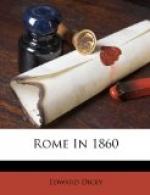About six o’clock the crowd from the Porta Pia had reassembled in the Corso. Six o’clock is always the fullest time in that street; private carriages are coming back from the Pincio promenade, and strangers are driving back to their hotels from the rounds of sight-seeing. The Corso, without doubt, was unusually and densely crowded; the footpaths swarmed with passengers, and, what was peculiarly galling to the Government, after the failure of the Carnival, there was a double line of aristocratic carriages passing up and down; still everything was perfectly peaceable and orderly. At the hour of the Ave Maria the crowd was at its fullest, and this was the time selected for the outrage. In a scene of general terror and confusion it is impossible to ascertain exact details of the order in which events occurred, but I believe the following account is fairly exact.
There were a great number of the Pontifical police, or sbirri, as the Romans call them, scattered in knots of two or three about the Corso; there were also several mounted patrols of the Papal gendarmes. The police did everything in their power to excite the people, hustled the crowd in every direction, used the most opprobrious epithets, and pushed their way along with insulting gestures. There are various stories afloat as to the immediate cause of the outbreak; one, that as a patrol passed the crowd hissed; another, that a cry was heard of “Viva Vittorio Emmanuele!” and a third, the Papal version, that on a young man of the name of Barberi being asked by a gendarme why he wore a violet flower on his coat, he answered rudely, and, on the officer trying to arrest him, his comrades pulled him away. All stories agree, that the provocation to the police was given in the Piazza Colonna; and the disturbance, if any, was so trivial, that a friend of mine, who was on the spot at the time, perceived nothing of it, and only fancies he heard a murmur as the police rode by. The provocation, whatever it was, was sufficient as a pretext for the premeditated outrage. The sbirri drew their swords, and slashing right and left, charged the dense crowds of men, women and children. The word was given, and a band of some twenty Papal dragoons, who had been drawn up hard by at the Monte Citorio, waiting under arms for the signal, galloped down the Corso, clearing their way with drawn swords. The sbirri along the street pulled out their cutlass-knives; the dragoons rode on the footway, and struck out at the carriages filled with ladies as they passed by, while the police ran a-muck (I can use no other word) amongst the terror-stricken crowd. The cries of the crushed and wounded, the terror of the women, and the savage, brutal fury of the police, added to the panic and confusion of the scene. Not the slightest attempt at resistance was made by the unarmed crowd; in a few minutes the Corso was cleared as if by magic, and order reigned in Rome.




